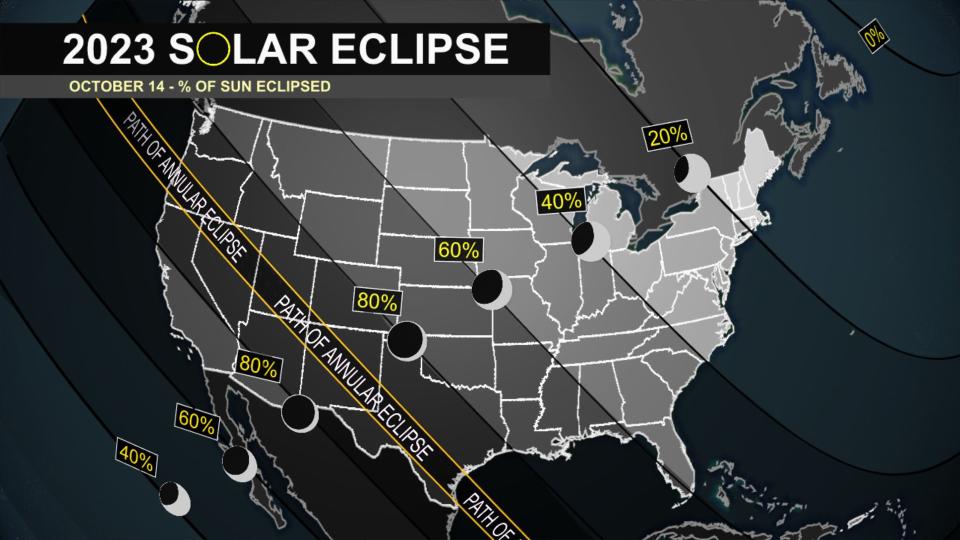Buresh Blog: Annular Solar Eclipse... 5 Years Since Hurricane Michael... Oct. Night Skies
Updates on the tropics every day: “Talking the Tropics With Mike”.
Sat., Oct. 14th Jacksonville/NE Fl./SE Ga. will be able to see a partial solar eclipse - part of the “full” annular eclipse that will be visible from Oregon to Texas. It’s an annular eclipse because even at totality, a portion of the outer sun (”ring of fire”) will be visible. For Jacksonville/NE FL. & SE Ga., just a little more than half of the sun will covered by the moon. REMEMBER TO NEVER LOOK AT THE SUN (ECLIPSED OR NOT) WITH THE NAKED EYE. And realize it’s safe to be outside during a solar eclipse just as long as you don’t look directly at the sun without protection for your eyes.
Then the countdown is on to the “Great American Eclipse” in April, 2024 with totality from Texas to Northern New England & a little more than two-thirds of the sun covered in Jacksonville - more * here * & includes an eclipse playlist & a look back at past solar eclipses. And the “Buresh Blog” about my experience at the 2017 total solar eclipse in S. Carolina * here *.



Michael hit the Florida Panhandle as a Cat. 5 hurricane 5 years ago, Oct. 10th in 2018. It was the first Cat. 5 U.S. landfall since “Andrew” hit South Florida in 1992. The Panhandle - Mexico Beach & the area about 60-80 miles either side of landfall - continue to rebuild to this day. I spent a weekend there in late January, 2019 catching up with folks who were rebuilding and telling their stories - see my “Buresh Blog” about that experience * here *.



Oct. night skies (Sky & Telescope):
Oct. 8 (morning): The Moon visits Cancer where it gleams some 3½° upper left of the Beehive Cluster (M44).
Oct. 9 (dawn): Venus, the Morning Star, blazes less than 2½° lower right of Regulus, Leo’s brightest star.
Oct. 10 (dawn): The thin lunar crescent is now in Leo where it forms a line with Venus and Regulus. Catch this sight before the Sun rises.
Oct. 14 (day): An annular solar eclipse will be visible along a narrow path through Oregon, Nevada, Utah, New Mexico, Texas, then the Yucatán and Central and South America. All of the U.S. will see a partial eclipse. More details.
Oct. 18 (dusk): The waxing crescent Moon and the Scorpion’s smoldering heart, Antares, sink toward the southwestern horizon with less than 5° between them.
Oct. 21–22 (night): The Orionid meteor shower peaks. The first-quarter Moon sets during the evening of the 21st.
Oct. 23 (evening): The waxing gibbous Moon hangs some 5° below Saturn. Look to the south-southwest to see the duo.
Oct. 28 (evening): The full Moon hangs a bit more than 2½° above Jupiter high in the southeast.
Oct. 28 (evening): A partial lunar eclipse is visible from the Eastern Hemisphere (but not from the United States).
Moon Phases
Last Quarter Oct. 6 9:48 a.m. EDT
New Moon Oct. 14 1:55 p.m. EDT (annular solar eclipse)
First Quarter Oct. 21 11:29 p.m. EDT
Full Moon Oct. 29 4:24 p.m. EDT (Hunter’s Moon)

